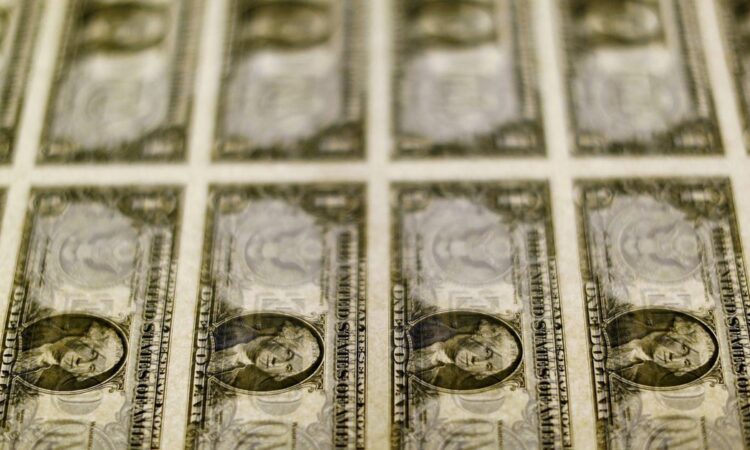
SINGAPORE, April 21 (Reuters) – The dollar headed for its first weekly gain in nearly two months on Friday as investors raised their bets that the Federal Reserve will increase rates in May, while a surprising recovery in the euro zone economy in April underpinned the euro.
The dollar index, which measures the performance of the U.S. currency against six others, rose 0.1% on the day and headed for a weekly gain of 0.4%, its first since late February.
The recovery in the euro zone unexpectedly gathered pace this month, thanks to a boom in services sector demand compensating for a deepening decline in manufacturing.
Preliminary surveys showed that same dynamic in Germany and France, the region’s two largest economies.
The euro was last flat against the dollar $1.0973 , but recovered from a session low of $1.0938. Against sterling, it rose 0.5% to 88.86 pence.
But the story this week has been one of dollar dominance. Fed officials have been at pains to point out that inflation remains uncomfortably high and rates must keep rising.
Money markets show traders believe there will be a quarter-point U.S. rate hike next month, which in theory is supportive of the dollar, but this will be quickly followed by a series of rate cuts, as the economy slows, which kept the U.S. currency’s gains in check.
“The rhetoric from the Fed is quite clear, but the market is still forging its own path of these rate cuts by the end of the year,” City Index strategist Fiona Cincotta said.
“At some point, there is going to be a reconciliation here – either the Fed gives some clues of a dovish pivot, or the market needs to reassess what’s going to be actually happening over the rest of the year,” she said.
Data on Thursday added to those concerns about recession, as the number of new claims for unemployment benefits rose, while factory activity in the mid-Atlantic manufacturing heartland hit a three-year low this month.
“The U.S. economy is heading to recession,” said Joseph Capurso, head of international and sustainable economics at Commonwealth Bank of Australia (CBA).
“But the problem for the Fed is that inflation is still sticky at a higher rate, so we still think the Fed is going to increase interest rates at least once more.”
Flash U.S. business activity surveys are due later and could offer a fuller picture of global economic health.
The pound took a knock from a drop in UK retail sales in March, as bad weather and high inflation kept British consumers away from the shops.
Paul Dales, chief UK economist at consultancy Capital Economics, said the survey by polling firm GfK suggested a brighter picture than the rain-affected March sales data.
“That said, even though the worst of the declines in retail sales are in the past, higher interest rates will restrain spending this year,” he said.
Sterling was last down 0.5% at $1.2385, having dropped by as much as 0.54% earlier on.
The yen was one of the stronger performers, edging higher against the dollar after data showed Japanese consumer inflation held steady above the central bank’s target in March, putting pressure on the Bank of Japan (BOJ) to ditch its ultra-loose monetary policy stance.
Incoming Governor Kazuo Ueda chairs his first BOJ policy meeting next week.
“I don’t think Ueda is going to change policy at his first meeting next week,” said CBA’s Capurso. “But there have been a few hints about a policy review, so that suggests to me that … they’ll move in the next few months.”
The yen was last up 0.3% against the dollar at 133.84 yen and up 0.3% against the euro at 133.84 yen.
Reporting by Rae Wee; Editing by Jamie Freed
Our Standards: The Thomson Reuters Trust Principles.




